Comparative Analysis of Australian and United States Interest Rates
VerifiedAdded on 2021/06/15
|14
|3921
|154
Report
AI Summary
This report provides a comparative analysis of the interest rates in Australia and the United States. It begins with an introduction to the Australian economy, highlighting its continuous growth, the Reserve Bank of Australia's (RBA) monetary policy decisions, including the maintained cash rate of 1.5%, and its expectations for economic growth, employment, and inflation. The report then examines the US Federal Reserve's decision to increase interest rates, detailing the economic factors influencing this move, such as a stable economy, increasing employment rates, and inflation near the 2% target. The report also discusses the potential impacts of these interest rate decisions on the respective economies, including implications for inflation, employment, and exchange rates. The RBA's monetary policy aims to maintain a steady economic growth through the setting of interest rates. The report analyzes the factors considered by both central banks in their monetary policy decisions and the potential effects of their actions on the economy. It concludes by evaluating the implications of these interest rate policies on key economic indicators in both countries.
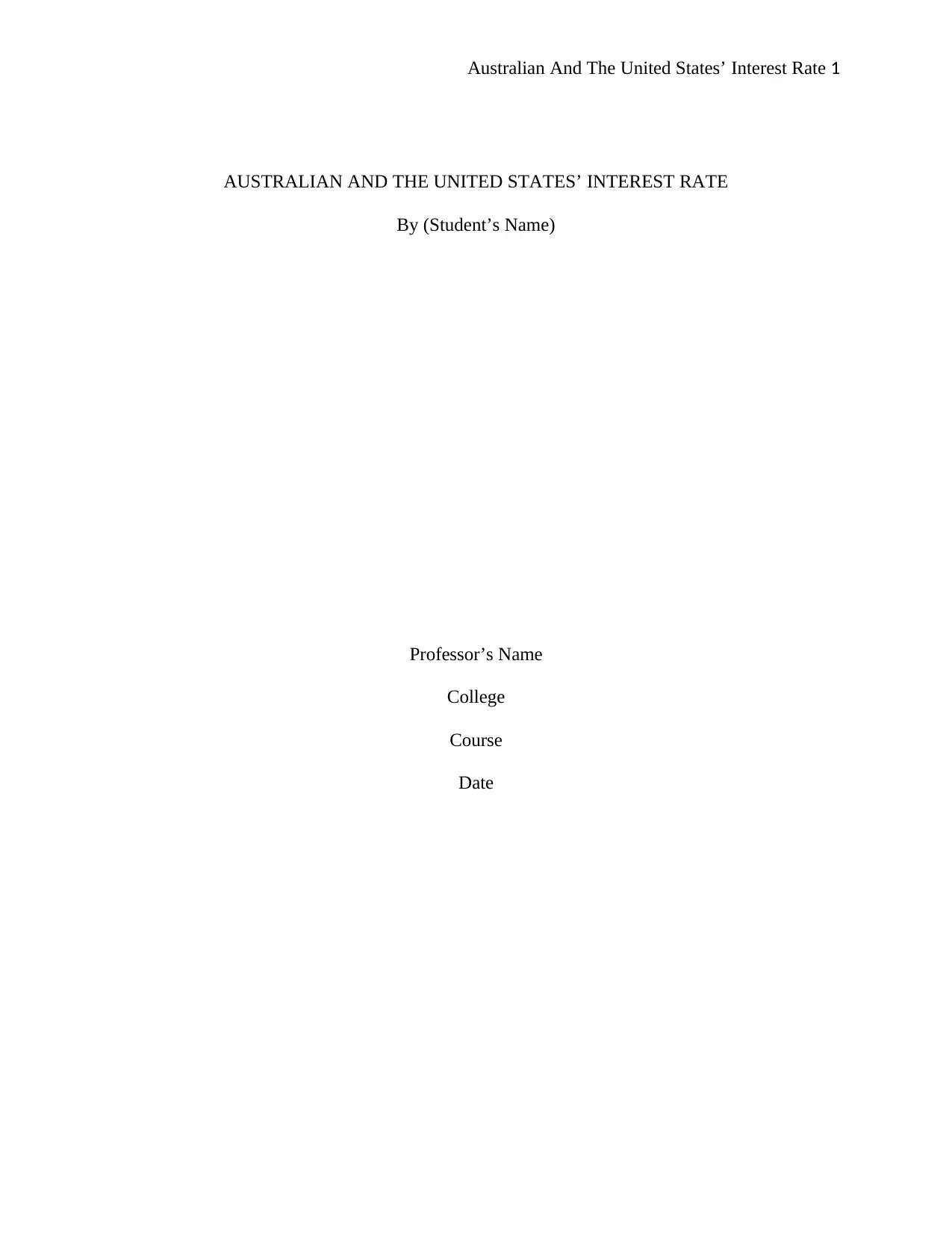
Australian And The United States’ Interest Rate 1
AUSTRALIAN AND THE UNITED STATES’ INTEREST RATE
By (Student’s Name)
Professor’s Name
College
Course
Date
AUSTRALIAN AND THE UNITED STATES’ INTEREST RATE
By (Student’s Name)
Professor’s Name
College
Course
Date
Paraphrase This Document
Need a fresh take? Get an instant paraphrase of this document with our AI Paraphraser
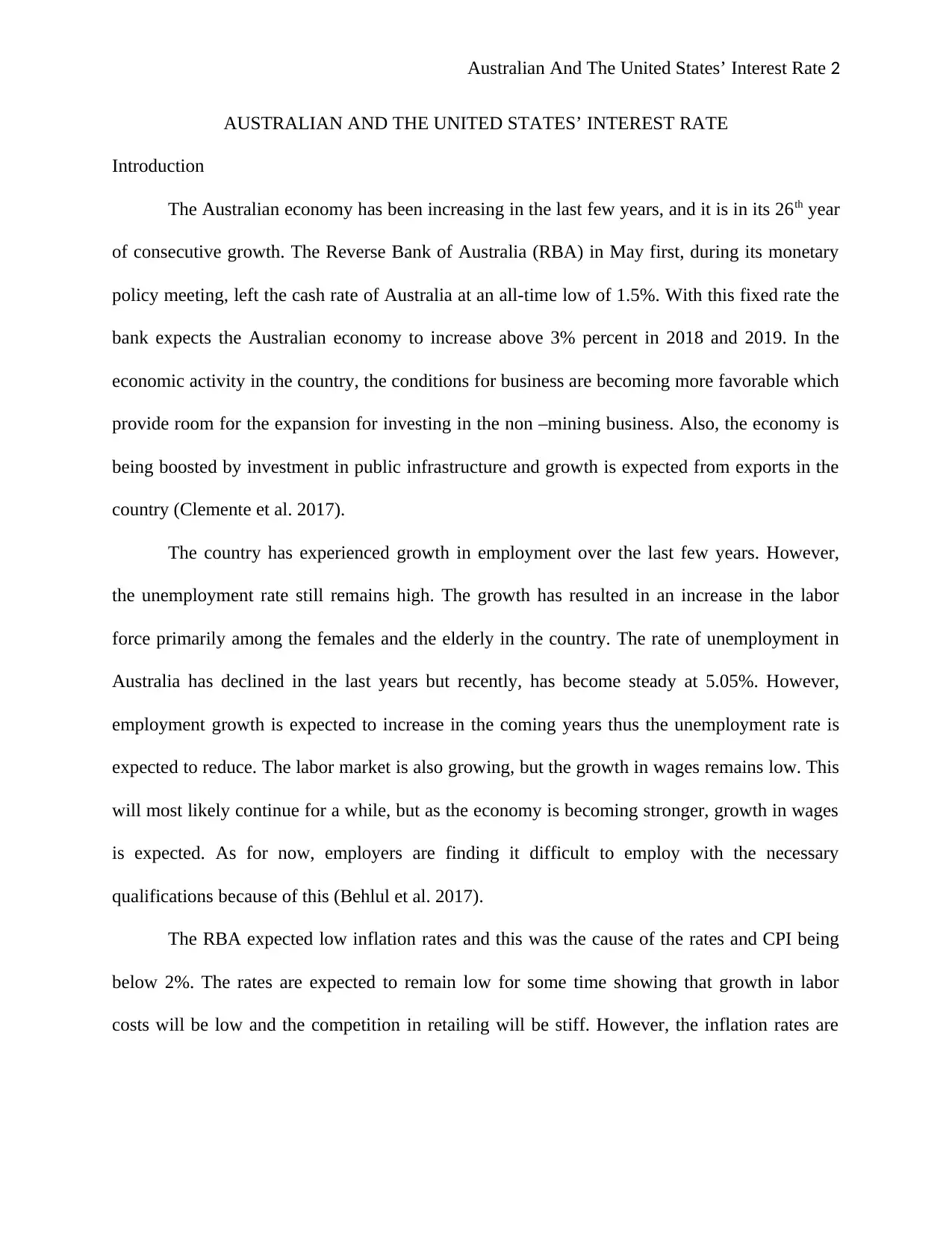
Australian And The United States’ Interest Rate 2
AUSTRALIAN AND THE UNITED STATES’ INTEREST RATE
Introduction
The Australian economy has been increasing in the last few years, and it is in its 26th year
of consecutive growth. The Reverse Bank of Australia (RBA) in May first, during its monetary
policy meeting, left the cash rate of Australia at an all-time low of 1.5%. With this fixed rate the
bank expects the Australian economy to increase above 3% percent in 2018 and 2019. In the
economic activity in the country, the conditions for business are becoming more favorable which
provide room for the expansion for investing in the non –mining business. Also, the economy is
being boosted by investment in public infrastructure and growth is expected from exports in the
country (Clemente et al. 2017).
The country has experienced growth in employment over the last few years. However,
the unemployment rate still remains high. The growth has resulted in an increase in the labor
force primarily among the females and the elderly in the country. The rate of unemployment in
Australia has declined in the last years but recently, has become steady at 5.05%. However,
employment growth is expected to increase in the coming years thus the unemployment rate is
expected to reduce. The labor market is also growing, but the growth in wages remains low. This
will most likely continue for a while, but as the economy is becoming stronger, growth in wages
is expected. As for now, employers are finding it difficult to employ with the necessary
qualifications because of this (Behlul et al. 2017).
The RBA expected low inflation rates and this was the cause of the rates and CPI being
below 2%. The rates are expected to remain low for some time showing that growth in labor
costs will be low and the competition in retailing will be stiff. However, the inflation rates are
AUSTRALIAN AND THE UNITED STATES’ INTEREST RATE
Introduction
The Australian economy has been increasing in the last few years, and it is in its 26th year
of consecutive growth. The Reverse Bank of Australia (RBA) in May first, during its monetary
policy meeting, left the cash rate of Australia at an all-time low of 1.5%. With this fixed rate the
bank expects the Australian economy to increase above 3% percent in 2018 and 2019. In the
economic activity in the country, the conditions for business are becoming more favorable which
provide room for the expansion for investing in the non –mining business. Also, the economy is
being boosted by investment in public infrastructure and growth is expected from exports in the
country (Clemente et al. 2017).
The country has experienced growth in employment over the last few years. However,
the unemployment rate still remains high. The growth has resulted in an increase in the labor
force primarily among the females and the elderly in the country. The rate of unemployment in
Australia has declined in the last years but recently, has become steady at 5.05%. However,
employment growth is expected to increase in the coming years thus the unemployment rate is
expected to reduce. The labor market is also growing, but the growth in wages remains low. This
will most likely continue for a while, but as the economy is becoming stronger, growth in wages
is expected. As for now, employers are finding it difficult to employ with the necessary
qualifications because of this (Behlul et al. 2017).
The RBA expected low inflation rates and this was the cause of the rates and CPI being
below 2%. The rates are expected to remain low for some time showing that growth in labor
costs will be low and the competition in retailing will be stiff. However, the inflation rates are
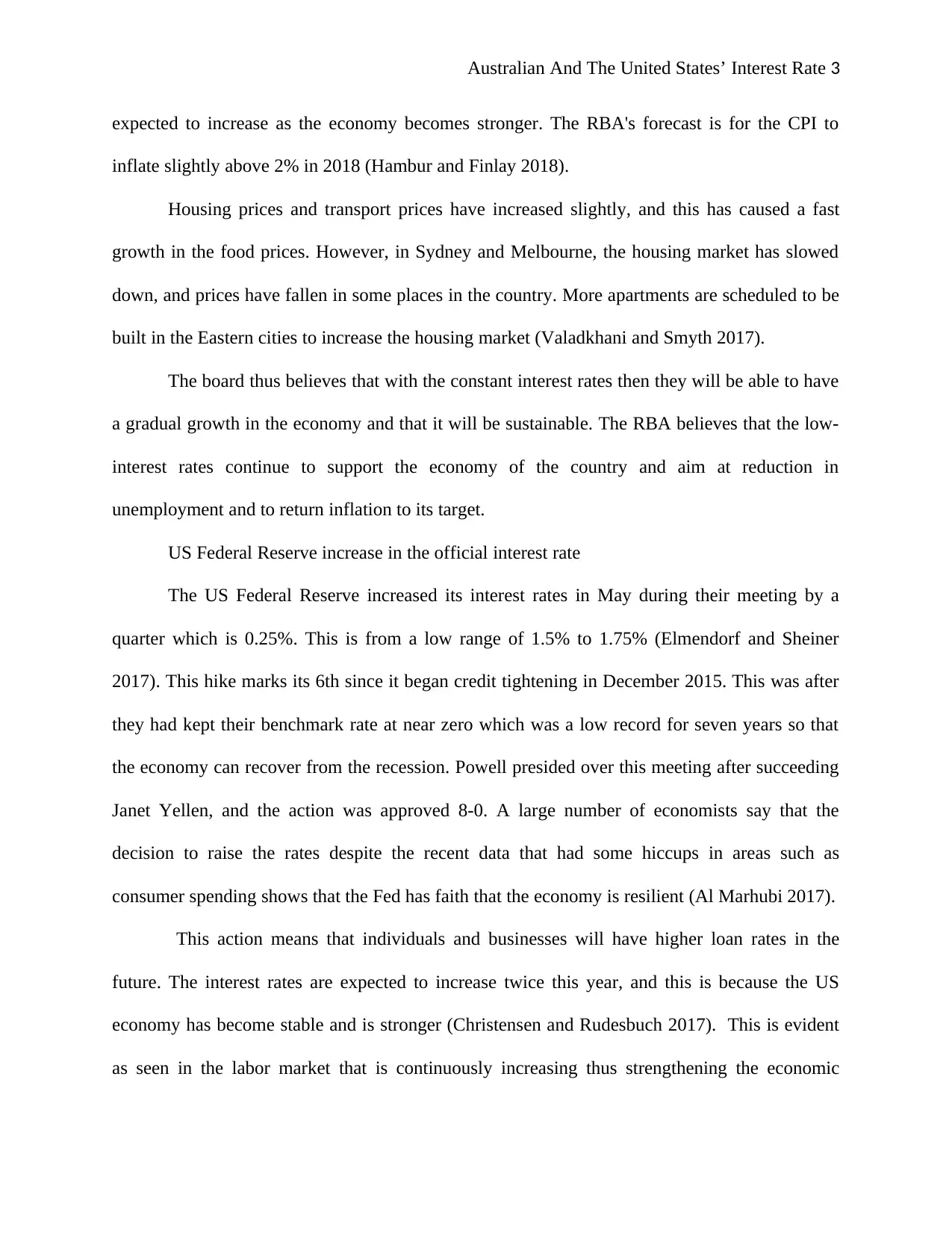
Australian And The United States’ Interest Rate 3
expected to increase as the economy becomes stronger. The RBA's forecast is for the CPI to
inflate slightly above 2% in 2018 (Hambur and Finlay 2018).
Housing prices and transport prices have increased slightly, and this has caused a fast
growth in the food prices. However, in Sydney and Melbourne, the housing market has slowed
down, and prices have fallen in some places in the country. More apartments are scheduled to be
built in the Eastern cities to increase the housing market (Valadkhani and Smyth 2017).
The board thus believes that with the constant interest rates then they will be able to have
a gradual growth in the economy and that it will be sustainable. The RBA believes that the low-
interest rates continue to support the economy of the country and aim at reduction in
unemployment and to return inflation to its target.
US Federal Reserve increase in the official interest rate
The US Federal Reserve increased its interest rates in May during their meeting by a
quarter which is 0.25%. This is from a low range of 1.5% to 1.75% (Elmendorf and Sheiner
2017). This hike marks its 6th since it began credit tightening in December 2015. This was after
they had kept their benchmark rate at near zero which was a low record for seven years so that
the economy can recover from the recession. Powell presided over this meeting after succeeding
Janet Yellen, and the action was approved 8-0. A large number of economists say that the
decision to raise the rates despite the recent data that had some hiccups in areas such as
consumer spending shows that the Fed has faith that the economy is resilient (Al Marhubi 2017).
This action means that individuals and businesses will have higher loan rates in the
future. The interest rates are expected to increase twice this year, and this is because the US
economy has become stable and is stronger (Christensen and Rudesbuch 2017). This is evident
as seen in the labor market that is continuously increasing thus strengthening the economic
expected to increase as the economy becomes stronger. The RBA's forecast is for the CPI to
inflate slightly above 2% in 2018 (Hambur and Finlay 2018).
Housing prices and transport prices have increased slightly, and this has caused a fast
growth in the food prices. However, in Sydney and Melbourne, the housing market has slowed
down, and prices have fallen in some places in the country. More apartments are scheduled to be
built in the Eastern cities to increase the housing market (Valadkhani and Smyth 2017).
The board thus believes that with the constant interest rates then they will be able to have
a gradual growth in the economy and that it will be sustainable. The RBA believes that the low-
interest rates continue to support the economy of the country and aim at reduction in
unemployment and to return inflation to its target.
US Federal Reserve increase in the official interest rate
The US Federal Reserve increased its interest rates in May during their meeting by a
quarter which is 0.25%. This is from a low range of 1.5% to 1.75% (Elmendorf and Sheiner
2017). This hike marks its 6th since it began credit tightening in December 2015. This was after
they had kept their benchmark rate at near zero which was a low record for seven years so that
the economy can recover from the recession. Powell presided over this meeting after succeeding
Janet Yellen, and the action was approved 8-0. A large number of economists say that the
decision to raise the rates despite the recent data that had some hiccups in areas such as
consumer spending shows that the Fed has faith that the economy is resilient (Al Marhubi 2017).
This action means that individuals and businesses will have higher loan rates in the
future. The interest rates are expected to increase twice this year, and this is because the US
economy has become stable and is stronger (Christensen and Rudesbuch 2017). This is evident
as seen in the labor market that is continuously increasing thus strengthening the economic
⊘ This is a preview!⊘
Do you want full access?
Subscribe today to unlock all pages.

Trusted by 1+ million students worldwide
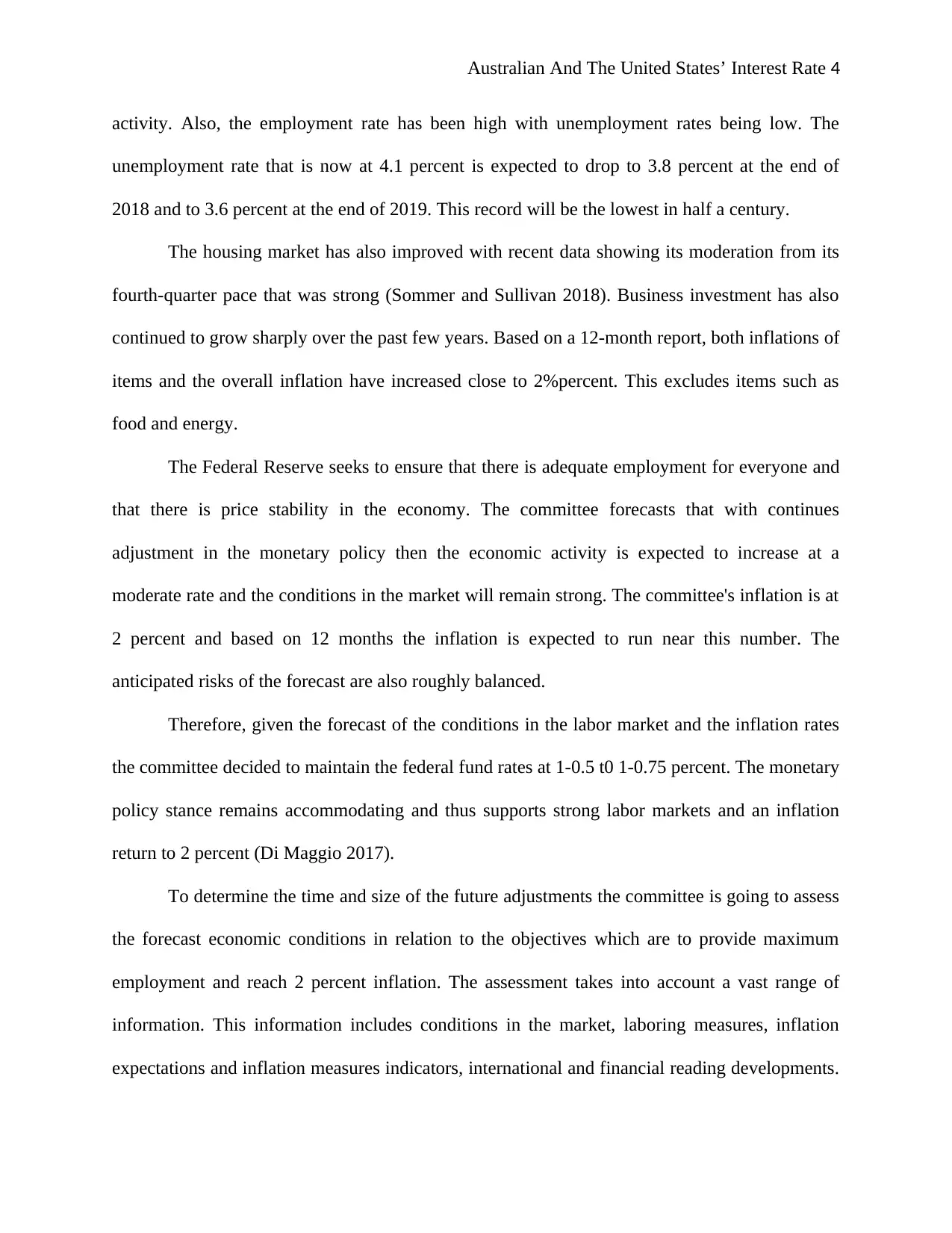
Australian And The United States’ Interest Rate 4
activity. Also, the employment rate has been high with unemployment rates being low. The
unemployment rate that is now at 4.1 percent is expected to drop to 3.8 percent at the end of
2018 and to 3.6 percent at the end of 2019. This record will be the lowest in half a century.
The housing market has also improved with recent data showing its moderation from its
fourth-quarter pace that was strong (Sommer and Sullivan 2018). Business investment has also
continued to grow sharply over the past few years. Based on a 12-month report, both inflations of
items and the overall inflation have increased close to 2%percent. This excludes items such as
food and energy.
The Federal Reserve seeks to ensure that there is adequate employment for everyone and
that there is price stability in the economy. The committee forecasts that with continues
adjustment in the monetary policy then the economic activity is expected to increase at a
moderate rate and the conditions in the market will remain strong. The committee's inflation is at
2 percent and based on 12 months the inflation is expected to run near this number. The
anticipated risks of the forecast are also roughly balanced.
Therefore, given the forecast of the conditions in the labor market and the inflation rates
the committee decided to maintain the federal fund rates at 1-0.5 t0 1-0.75 percent. The monetary
policy stance remains accommodating and thus supports strong labor markets and an inflation
return to 2 percent (Di Maggio 2017).
To determine the time and size of the future adjustments the committee is going to assess
the forecast economic conditions in relation to the objectives which are to provide maximum
employment and reach 2 percent inflation. The assessment takes into account a vast range of
information. This information includes conditions in the market, laboring measures, inflation
expectations and inflation measures indicators, international and financial reading developments.
activity. Also, the employment rate has been high with unemployment rates being low. The
unemployment rate that is now at 4.1 percent is expected to drop to 3.8 percent at the end of
2018 and to 3.6 percent at the end of 2019. This record will be the lowest in half a century.
The housing market has also improved with recent data showing its moderation from its
fourth-quarter pace that was strong (Sommer and Sullivan 2018). Business investment has also
continued to grow sharply over the past few years. Based on a 12-month report, both inflations of
items and the overall inflation have increased close to 2%percent. This excludes items such as
food and energy.
The Federal Reserve seeks to ensure that there is adequate employment for everyone and
that there is price stability in the economy. The committee forecasts that with continues
adjustment in the monetary policy then the economic activity is expected to increase at a
moderate rate and the conditions in the market will remain strong. The committee's inflation is at
2 percent and based on 12 months the inflation is expected to run near this number. The
anticipated risks of the forecast are also roughly balanced.
Therefore, given the forecast of the conditions in the labor market and the inflation rates
the committee decided to maintain the federal fund rates at 1-0.5 t0 1-0.75 percent. The monetary
policy stance remains accommodating and thus supports strong labor markets and an inflation
return to 2 percent (Di Maggio 2017).
To determine the time and size of the future adjustments the committee is going to assess
the forecast economic conditions in relation to the objectives which are to provide maximum
employment and reach 2 percent inflation. The assessment takes into account a vast range of
information. This information includes conditions in the market, laboring measures, inflation
expectations and inflation measures indicators, international and financial reading developments.
Paraphrase This Document
Need a fresh take? Get an instant paraphrase of this document with our AI Paraphraser
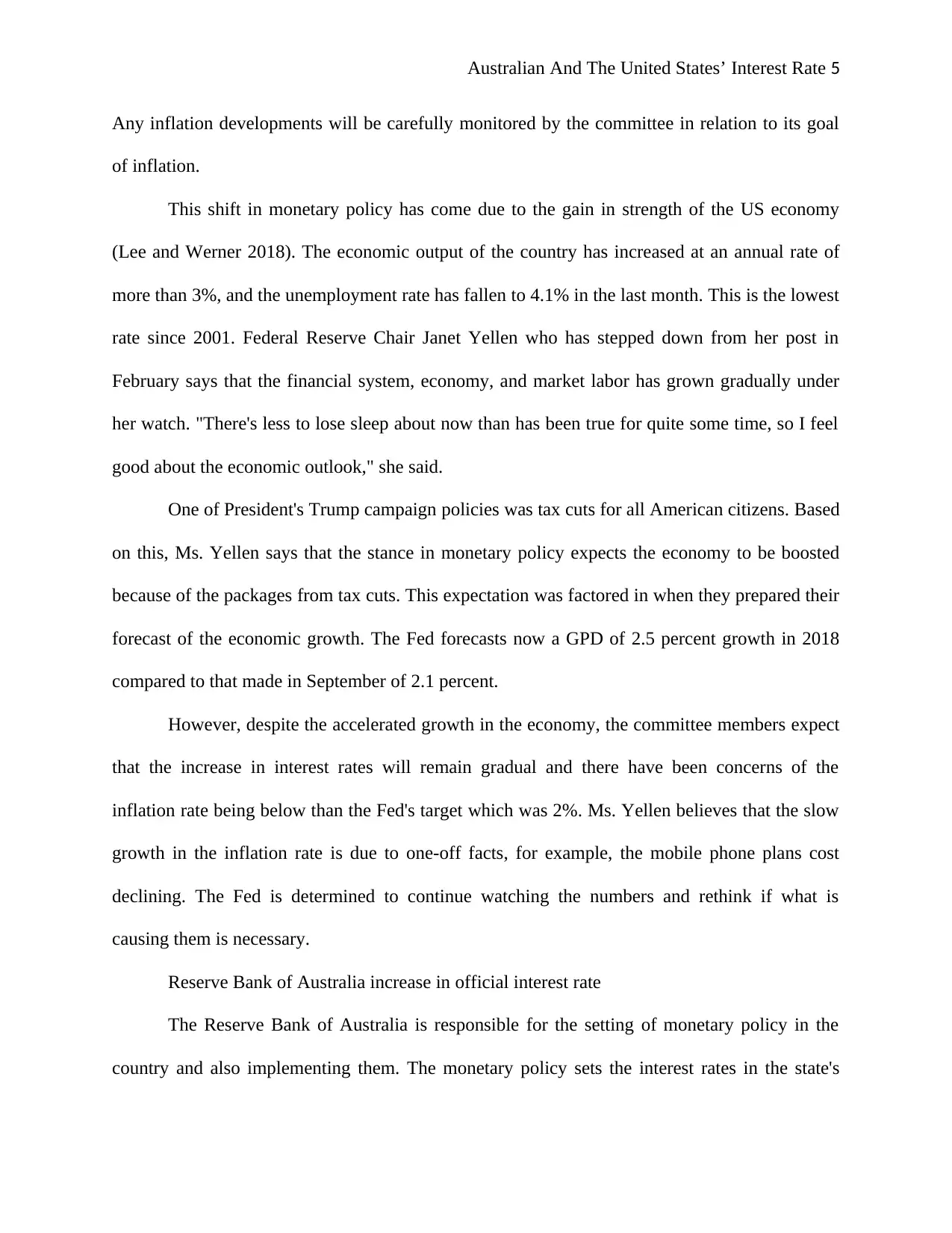
Australian And The United States’ Interest Rate 5
Any inflation developments will be carefully monitored by the committee in relation to its goal
of inflation.
This shift in monetary policy has come due to the gain in strength of the US economy
(Lee and Werner 2018). The economic output of the country has increased at an annual rate of
more than 3%, and the unemployment rate has fallen to 4.1% in the last month. This is the lowest
rate since 2001. Federal Reserve Chair Janet Yellen who has stepped down from her post in
February says that the financial system, economy, and market labor has grown gradually under
her watch. "There's less to lose sleep about now than has been true for quite some time, so I feel
good about the economic outlook," she said.
One of President's Trump campaign policies was tax cuts for all American citizens. Based
on this, Ms. Yellen says that the stance in monetary policy expects the economy to be boosted
because of the packages from tax cuts. This expectation was factored in when they prepared their
forecast of the economic growth. The Fed forecasts now a GPD of 2.5 percent growth in 2018
compared to that made in September of 2.1 percent.
However, despite the accelerated growth in the economy, the committee members expect
that the increase in interest rates will remain gradual and there have been concerns of the
inflation rate being below than the Fed's target which was 2%. Ms. Yellen believes that the slow
growth in the inflation rate is due to one-off facts, for example, the mobile phone plans cost
declining. The Fed is determined to continue watching the numbers and rethink if what is
causing them is necessary.
Reserve Bank of Australia increase in official interest rate
The Reserve Bank of Australia is responsible for the setting of monetary policy in the
country and also implementing them. The monetary policy sets the interest rates in the state's
Any inflation developments will be carefully monitored by the committee in relation to its goal
of inflation.
This shift in monetary policy has come due to the gain in strength of the US economy
(Lee and Werner 2018). The economic output of the country has increased at an annual rate of
more than 3%, and the unemployment rate has fallen to 4.1% in the last month. This is the lowest
rate since 2001. Federal Reserve Chair Janet Yellen who has stepped down from her post in
February says that the financial system, economy, and market labor has grown gradually under
her watch. "There's less to lose sleep about now than has been true for quite some time, so I feel
good about the economic outlook," she said.
One of President's Trump campaign policies was tax cuts for all American citizens. Based
on this, Ms. Yellen says that the stance in monetary policy expects the economy to be boosted
because of the packages from tax cuts. This expectation was factored in when they prepared their
forecast of the economic growth. The Fed forecasts now a GPD of 2.5 percent growth in 2018
compared to that made in September of 2.1 percent.
However, despite the accelerated growth in the economy, the committee members expect
that the increase in interest rates will remain gradual and there have been concerns of the
inflation rate being below than the Fed's target which was 2%. Ms. Yellen believes that the slow
growth in the inflation rate is due to one-off facts, for example, the mobile phone plans cost
declining. The Fed is determined to continue watching the numbers and rethink if what is
causing them is necessary.
Reserve Bank of Australia increase in official interest rate
The Reserve Bank of Australia is responsible for the setting of monetary policy in the
country and also implementing them. The monetary policy sets the interest rates in the state's
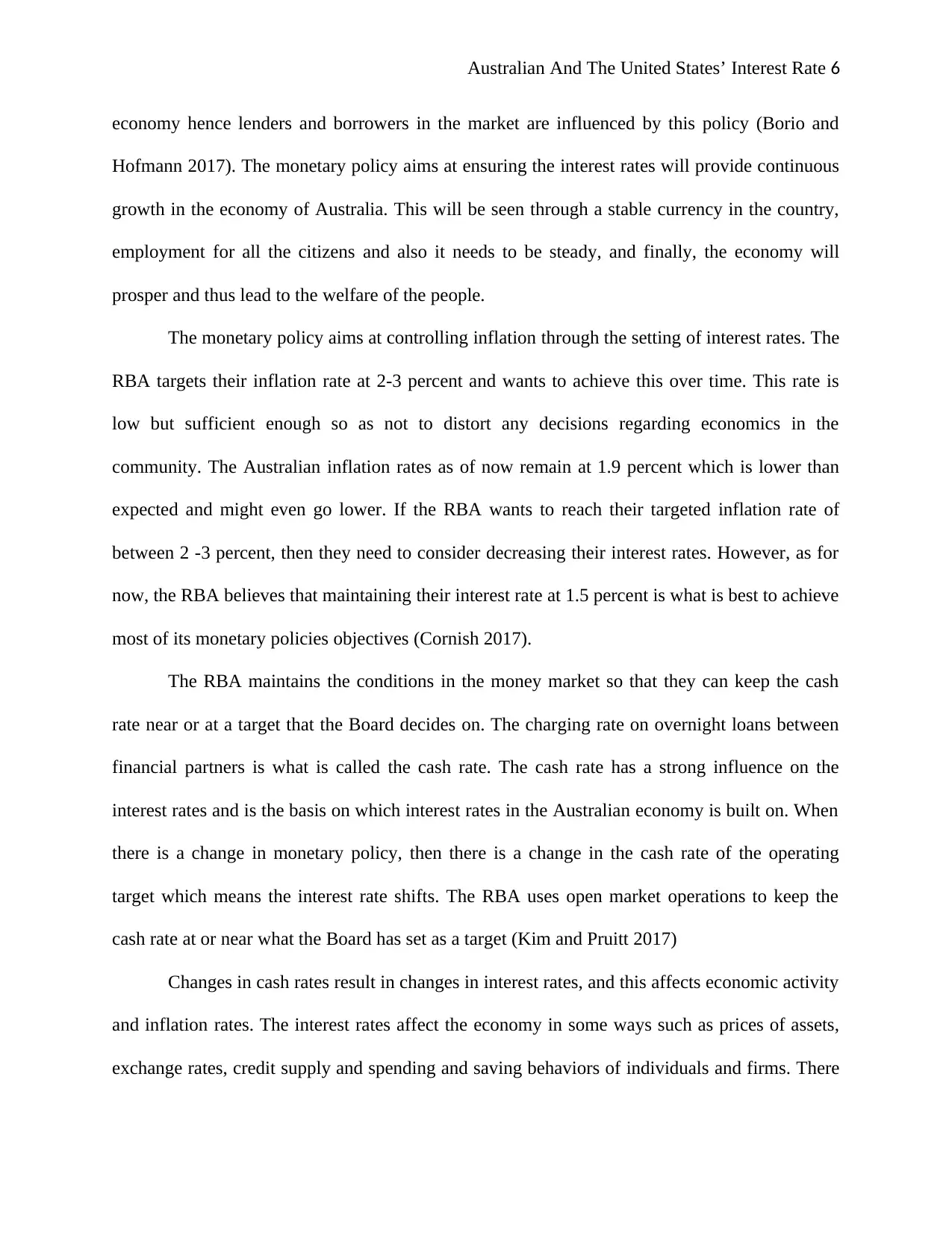
Australian And The United States’ Interest Rate 6
economy hence lenders and borrowers in the market are influenced by this policy (Borio and
Hofmann 2017). The monetary policy aims at ensuring the interest rates will provide continuous
growth in the economy of Australia. This will be seen through a stable currency in the country,
employment for all the citizens and also it needs to be steady, and finally, the economy will
prosper and thus lead to the welfare of the people.
The monetary policy aims at controlling inflation through the setting of interest rates. The
RBA targets their inflation rate at 2-3 percent and wants to achieve this over time. This rate is
low but sufficient enough so as not to distort any decisions regarding economics in the
community. The Australian inflation rates as of now remain at 1.9 percent which is lower than
expected and might even go lower. If the RBA wants to reach their targeted inflation rate of
between 2 -3 percent, then they need to consider decreasing their interest rates. However, as for
now, the RBA believes that maintaining their interest rate at 1.5 percent is what is best to achieve
most of its monetary policies objectives (Cornish 2017).
The RBA maintains the conditions in the money market so that they can keep the cash
rate near or at a target that the Board decides on. The charging rate on overnight loans between
financial partners is what is called the cash rate. The cash rate has a strong influence on the
interest rates and is the basis on which interest rates in the Australian economy is built on. When
there is a change in monetary policy, then there is a change in the cash rate of the operating
target which means the interest rate shifts. The RBA uses open market operations to keep the
cash rate at or near what the Board has set as a target (Kim and Pruitt 2017)
Changes in cash rates result in changes in interest rates, and this affects economic activity
and inflation rates. The interest rates affect the economy in some ways such as prices of assets,
exchange rates, credit supply and spending and saving behaviors of individuals and firms. There
economy hence lenders and borrowers in the market are influenced by this policy (Borio and
Hofmann 2017). The monetary policy aims at ensuring the interest rates will provide continuous
growth in the economy of Australia. This will be seen through a stable currency in the country,
employment for all the citizens and also it needs to be steady, and finally, the economy will
prosper and thus lead to the welfare of the people.
The monetary policy aims at controlling inflation through the setting of interest rates. The
RBA targets their inflation rate at 2-3 percent and wants to achieve this over time. This rate is
low but sufficient enough so as not to distort any decisions regarding economics in the
community. The Australian inflation rates as of now remain at 1.9 percent which is lower than
expected and might even go lower. If the RBA wants to reach their targeted inflation rate of
between 2 -3 percent, then they need to consider decreasing their interest rates. However, as for
now, the RBA believes that maintaining their interest rate at 1.5 percent is what is best to achieve
most of its monetary policies objectives (Cornish 2017).
The RBA maintains the conditions in the money market so that they can keep the cash
rate near or at a target that the Board decides on. The charging rate on overnight loans between
financial partners is what is called the cash rate. The cash rate has a strong influence on the
interest rates and is the basis on which interest rates in the Australian economy is built on. When
there is a change in monetary policy, then there is a change in the cash rate of the operating
target which means the interest rate shifts. The RBA uses open market operations to keep the
cash rate at or near what the Board has set as a target (Kim and Pruitt 2017)
Changes in cash rates result in changes in interest rates, and this affects economic activity
and inflation rates. The interest rates affect the economy in some ways such as prices of assets,
exchange rates, credit supply and spending and saving behaviors of individuals and firms. There
⊘ This is a preview!⊘
Do you want full access?
Subscribe today to unlock all pages.

Trusted by 1+ million students worldwide
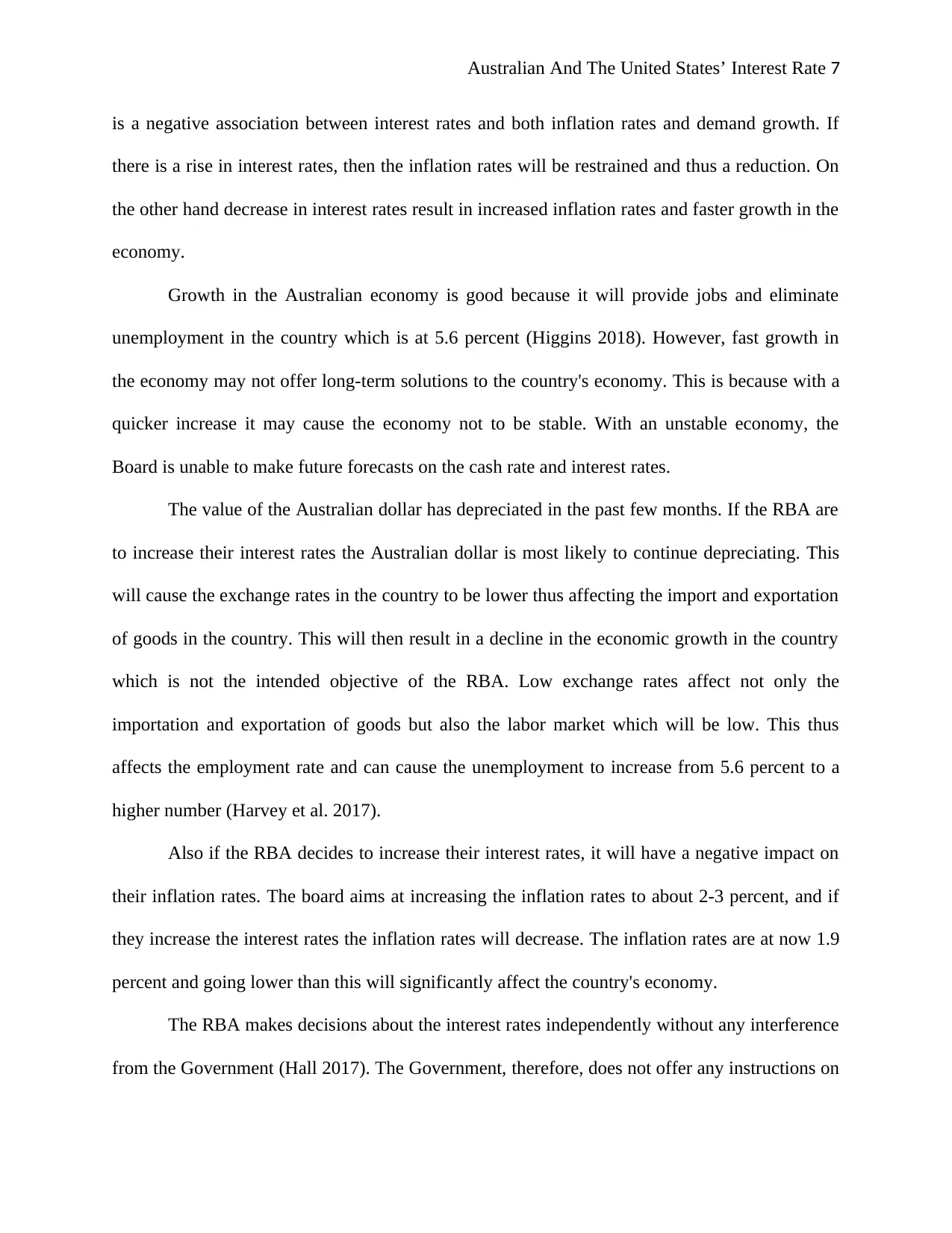
Australian And The United States’ Interest Rate 7
is a negative association between interest rates and both inflation rates and demand growth. If
there is a rise in interest rates, then the inflation rates will be restrained and thus a reduction. On
the other hand decrease in interest rates result in increased inflation rates and faster growth in the
economy.
Growth in the Australian economy is good because it will provide jobs and eliminate
unemployment in the country which is at 5.6 percent (Higgins 2018). However, fast growth in
the economy may not offer long-term solutions to the country's economy. This is because with a
quicker increase it may cause the economy not to be stable. With an unstable economy, the
Board is unable to make future forecasts on the cash rate and interest rates.
The value of the Australian dollar has depreciated in the past few months. If the RBA are
to increase their interest rates the Australian dollar is most likely to continue depreciating. This
will cause the exchange rates in the country to be lower thus affecting the import and exportation
of goods in the country. This will then result in a decline in the economic growth in the country
which is not the intended objective of the RBA. Low exchange rates affect not only the
importation and exportation of goods but also the labor market which will be low. This thus
affects the employment rate and can cause the unemployment to increase from 5.6 percent to a
higher number (Harvey et al. 2017).
Also if the RBA decides to increase their interest rates, it will have a negative impact on
their inflation rates. The board aims at increasing the inflation rates to about 2-3 percent, and if
they increase the interest rates the inflation rates will decrease. The inflation rates are at now 1.9
percent and going lower than this will significantly affect the country's economy.
The RBA makes decisions about the interest rates independently without any interference
from the Government (Hall 2017). The Government, therefore, does not offer any instructions on
is a negative association between interest rates and both inflation rates and demand growth. If
there is a rise in interest rates, then the inflation rates will be restrained and thus a reduction. On
the other hand decrease in interest rates result in increased inflation rates and faster growth in the
economy.
Growth in the Australian economy is good because it will provide jobs and eliminate
unemployment in the country which is at 5.6 percent (Higgins 2018). However, fast growth in
the economy may not offer long-term solutions to the country's economy. This is because with a
quicker increase it may cause the economy not to be stable. With an unstable economy, the
Board is unable to make future forecasts on the cash rate and interest rates.
The value of the Australian dollar has depreciated in the past few months. If the RBA are
to increase their interest rates the Australian dollar is most likely to continue depreciating. This
will cause the exchange rates in the country to be lower thus affecting the import and exportation
of goods in the country. This will then result in a decline in the economic growth in the country
which is not the intended objective of the RBA. Low exchange rates affect not only the
importation and exportation of goods but also the labor market which will be low. This thus
affects the employment rate and can cause the unemployment to increase from 5.6 percent to a
higher number (Harvey et al. 2017).
Also if the RBA decides to increase their interest rates, it will have a negative impact on
their inflation rates. The board aims at increasing the inflation rates to about 2-3 percent, and if
they increase the interest rates the inflation rates will decrease. The inflation rates are at now 1.9
percent and going lower than this will significantly affect the country's economy.
The RBA makes decisions about the interest rates independently without any interference
from the Government (Hall 2017). The Government, therefore, does not offer any instructions on
Paraphrase This Document
Need a fresh take? Get an instant paraphrase of this document with our AI Paraphraser
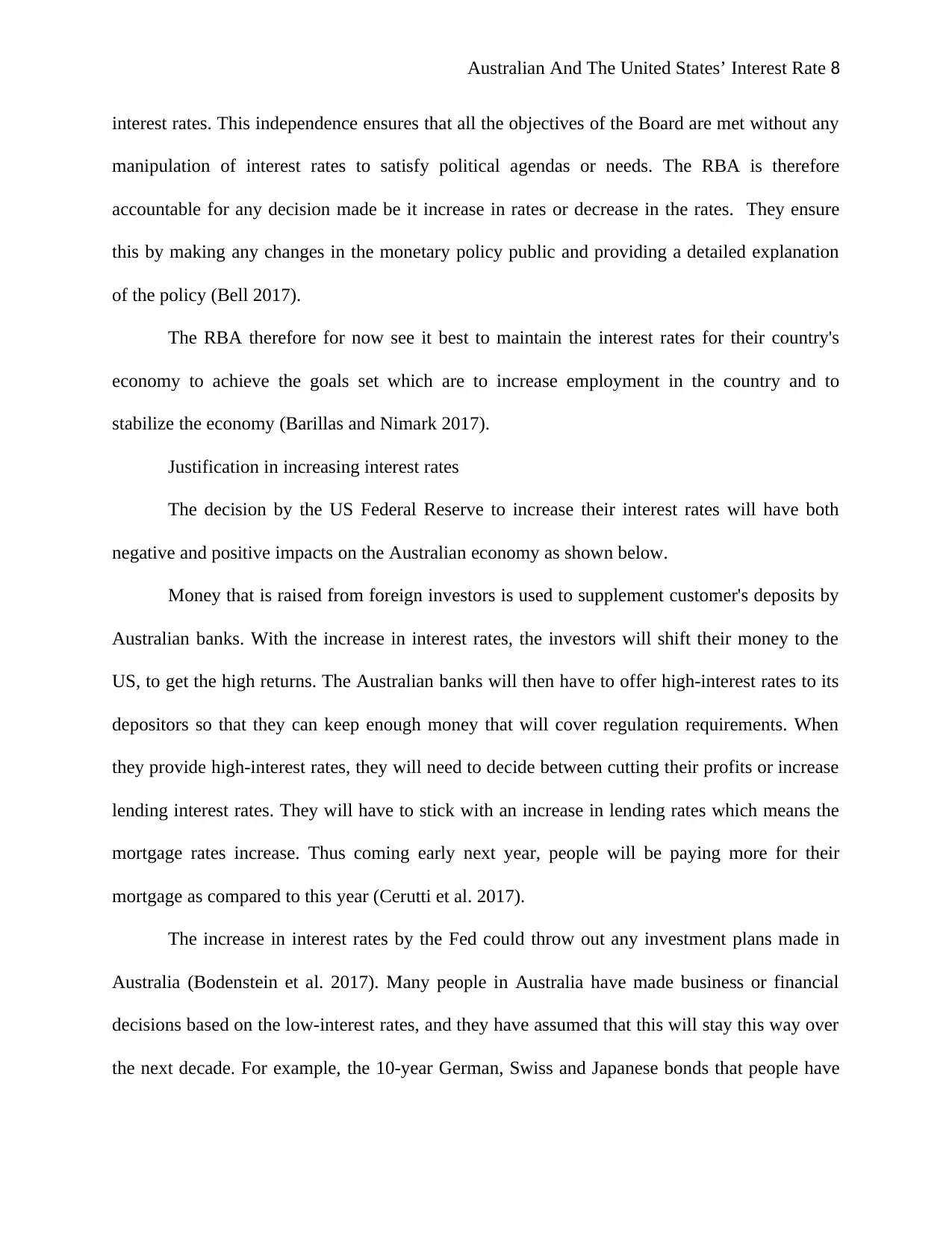
Australian And The United States’ Interest Rate 8
interest rates. This independence ensures that all the objectives of the Board are met without any
manipulation of interest rates to satisfy political agendas or needs. The RBA is therefore
accountable for any decision made be it increase in rates or decrease in the rates. They ensure
this by making any changes in the monetary policy public and providing a detailed explanation
of the policy (Bell 2017).
The RBA therefore for now see it best to maintain the interest rates for their country's
economy to achieve the goals set which are to increase employment in the country and to
stabilize the economy (Barillas and Nimark 2017).
Justification in increasing interest rates
The decision by the US Federal Reserve to increase their interest rates will have both
negative and positive impacts on the Australian economy as shown below.
Money that is raised from foreign investors is used to supplement customer's deposits by
Australian banks. With the increase in interest rates, the investors will shift their money to the
US, to get the high returns. The Australian banks will then have to offer high-interest rates to its
depositors so that they can keep enough money that will cover regulation requirements. When
they provide high-interest rates, they will need to decide between cutting their profits or increase
lending interest rates. They will have to stick with an increase in lending rates which means the
mortgage rates increase. Thus coming early next year, people will be paying more for their
mortgage as compared to this year (Cerutti et al. 2017).
The increase in interest rates by the Fed could throw out any investment plans made in
Australia (Bodenstein et al. 2017). Many people in Australia have made business or financial
decisions based on the low-interest rates, and they have assumed that this will stay this way over
the next decade. For example, the 10-year German, Swiss and Japanese bonds that people have
interest rates. This independence ensures that all the objectives of the Board are met without any
manipulation of interest rates to satisfy political agendas or needs. The RBA is therefore
accountable for any decision made be it increase in rates or decrease in the rates. They ensure
this by making any changes in the monetary policy public and providing a detailed explanation
of the policy (Bell 2017).
The RBA therefore for now see it best to maintain the interest rates for their country's
economy to achieve the goals set which are to increase employment in the country and to
stabilize the economy (Barillas and Nimark 2017).
Justification in increasing interest rates
The decision by the US Federal Reserve to increase their interest rates will have both
negative and positive impacts on the Australian economy as shown below.
Money that is raised from foreign investors is used to supplement customer's deposits by
Australian banks. With the increase in interest rates, the investors will shift their money to the
US, to get the high returns. The Australian banks will then have to offer high-interest rates to its
depositors so that they can keep enough money that will cover regulation requirements. When
they provide high-interest rates, they will need to decide between cutting their profits or increase
lending interest rates. They will have to stick with an increase in lending rates which means the
mortgage rates increase. Thus coming early next year, people will be paying more for their
mortgage as compared to this year (Cerutti et al. 2017).
The increase in interest rates by the Fed could throw out any investment plans made in
Australia (Bodenstein et al. 2017). Many people in Australia have made business or financial
decisions based on the low-interest rates, and they have assumed that this will stay this way over
the next decade. For example, the 10-year German, Swiss and Japanese bonds that people have

Australian And The United States’ Interest Rate 9
bought. The aim is to get good returns at the end of the period. With the increase in interest rates
then it means people will lose money through the negative rates and the money value will have
depreciated because of inflation.
Also with the interest rates in US and Australia diverging the Australian dollar is most
likely looking vulnerable and its value may depreciate in the future. However, Westpac's Bill
Evans who is the Chief of economy says that the increase in the interest rates by Fed will cause
an increase in commodity prices which can hold the Australian dollar for longer. Commodities
such as iron ore are the ones holding up the Australian dollar from going downhill.
The higher interest rates also affect the exchange rate in the country. With higher interest
rates in the US, the exchange rates will be high since more investors will be attracted. Australia,
therefore, can benefit from investing there because the returns will be good which can boost their
economy (Eichenbaum et al. 2017).
On the other hand, the high-interest rates can cause unemployment in Australia. The
country will lose a lot of investors who are looking for better returns. This will force firms to
borrow from banks which cost more, and it will result in a reduction in consumption which
causes less demand for workers. Many people will have to be fired to cut costs in companies and
thus many left unemployed. This will increase the unemployment rate in Australia that the board
aimed at reducing.
Lastly, the Australian economy will be significantly affected due to the Fed's increase in
interest rates. Businesses and investments will not boom as expected because they cannot make
large purchases due to the high-interest rates and thus there will be no growth in the economy.
Also, consumers of products will not pay little in interest and therefore will not have much
money to spend also hurting the country's economy (Hartwell 2017).
bought. The aim is to get good returns at the end of the period. With the increase in interest rates
then it means people will lose money through the negative rates and the money value will have
depreciated because of inflation.
Also with the interest rates in US and Australia diverging the Australian dollar is most
likely looking vulnerable and its value may depreciate in the future. However, Westpac's Bill
Evans who is the Chief of economy says that the increase in the interest rates by Fed will cause
an increase in commodity prices which can hold the Australian dollar for longer. Commodities
such as iron ore are the ones holding up the Australian dollar from going downhill.
The higher interest rates also affect the exchange rate in the country. With higher interest
rates in the US, the exchange rates will be high since more investors will be attracted. Australia,
therefore, can benefit from investing there because the returns will be good which can boost their
economy (Eichenbaum et al. 2017).
On the other hand, the high-interest rates can cause unemployment in Australia. The
country will lose a lot of investors who are looking for better returns. This will force firms to
borrow from banks which cost more, and it will result in a reduction in consumption which
causes less demand for workers. Many people will have to be fired to cut costs in companies and
thus many left unemployed. This will increase the unemployment rate in Australia that the board
aimed at reducing.
Lastly, the Australian economy will be significantly affected due to the Fed's increase in
interest rates. Businesses and investments will not boom as expected because they cannot make
large purchases due to the high-interest rates and thus there will be no growth in the economy.
Also, consumers of products will not pay little in interest and therefore will not have much
money to spend also hurting the country's economy (Hartwell 2017).
⊘ This is a preview!⊘
Do you want full access?
Subscribe today to unlock all pages.

Trusted by 1+ million students worldwide
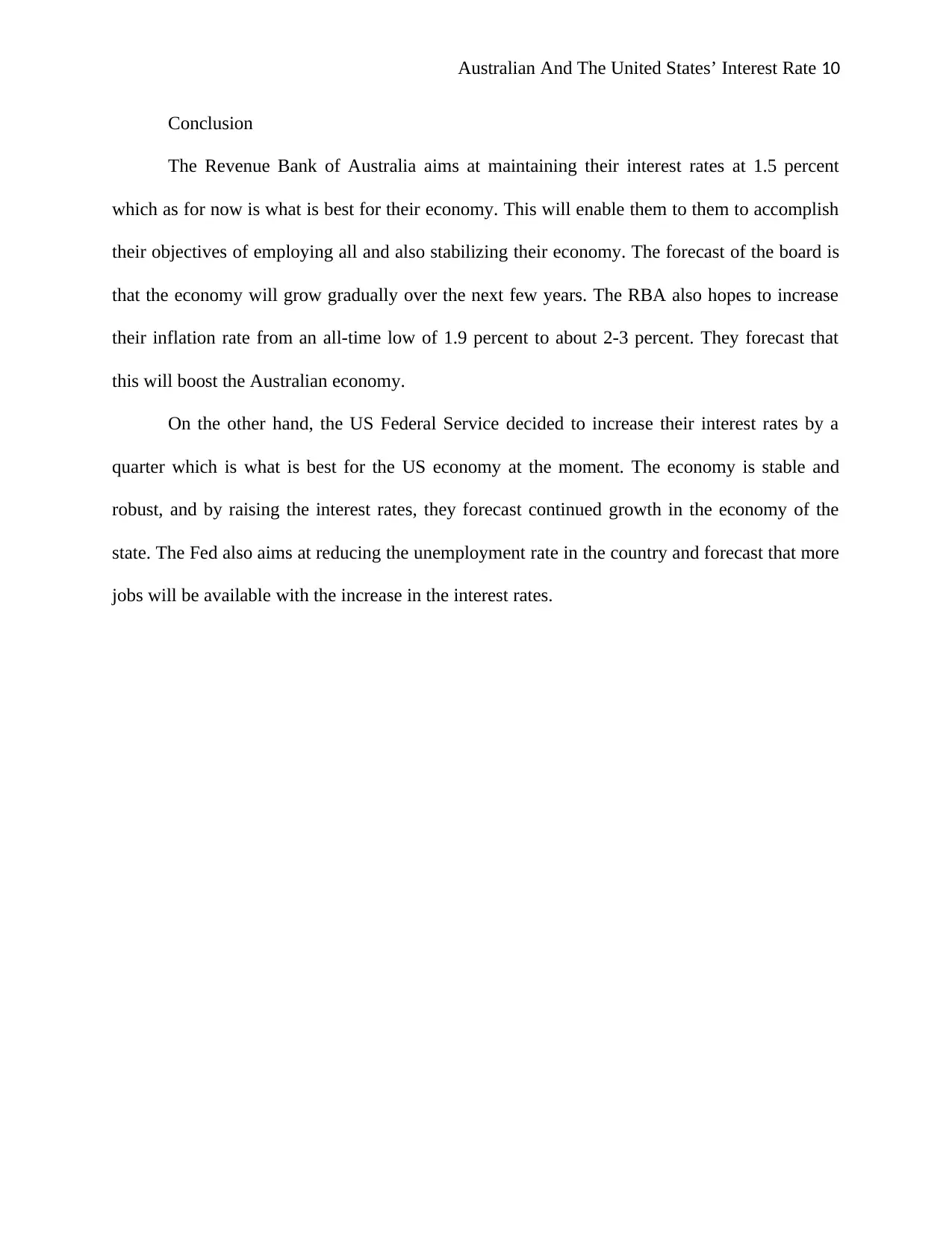
Australian And The United States’ Interest Rate 10
Conclusion
The Revenue Bank of Australia aims at maintaining their interest rates at 1.5 percent
which as for now is what is best for their economy. This will enable them to them to accomplish
their objectives of employing all and also stabilizing their economy. The forecast of the board is
that the economy will grow gradually over the next few years. The RBA also hopes to increase
their inflation rate from an all-time low of 1.9 percent to about 2-3 percent. They forecast that
this will boost the Australian economy.
On the other hand, the US Federal Service decided to increase their interest rates by a
quarter which is what is best for the US economy at the moment. The economy is stable and
robust, and by raising the interest rates, they forecast continued growth in the economy of the
state. The Fed also aims at reducing the unemployment rate in the country and forecast that more
jobs will be available with the increase in the interest rates.
Conclusion
The Revenue Bank of Australia aims at maintaining their interest rates at 1.5 percent
which as for now is what is best for their economy. This will enable them to them to accomplish
their objectives of employing all and also stabilizing their economy. The forecast of the board is
that the economy will grow gradually over the next few years. The RBA also hopes to increase
their inflation rate from an all-time low of 1.9 percent to about 2-3 percent. They forecast that
this will boost the Australian economy.
On the other hand, the US Federal Service decided to increase their interest rates by a
quarter which is what is best for the US economy at the moment. The economy is stable and
robust, and by raising the interest rates, they forecast continued growth in the economy of the
state. The Fed also aims at reducing the unemployment rate in the country and forecast that more
jobs will be available with the increase in the interest rates.
Paraphrase This Document
Need a fresh take? Get an instant paraphrase of this document with our AI Paraphraser
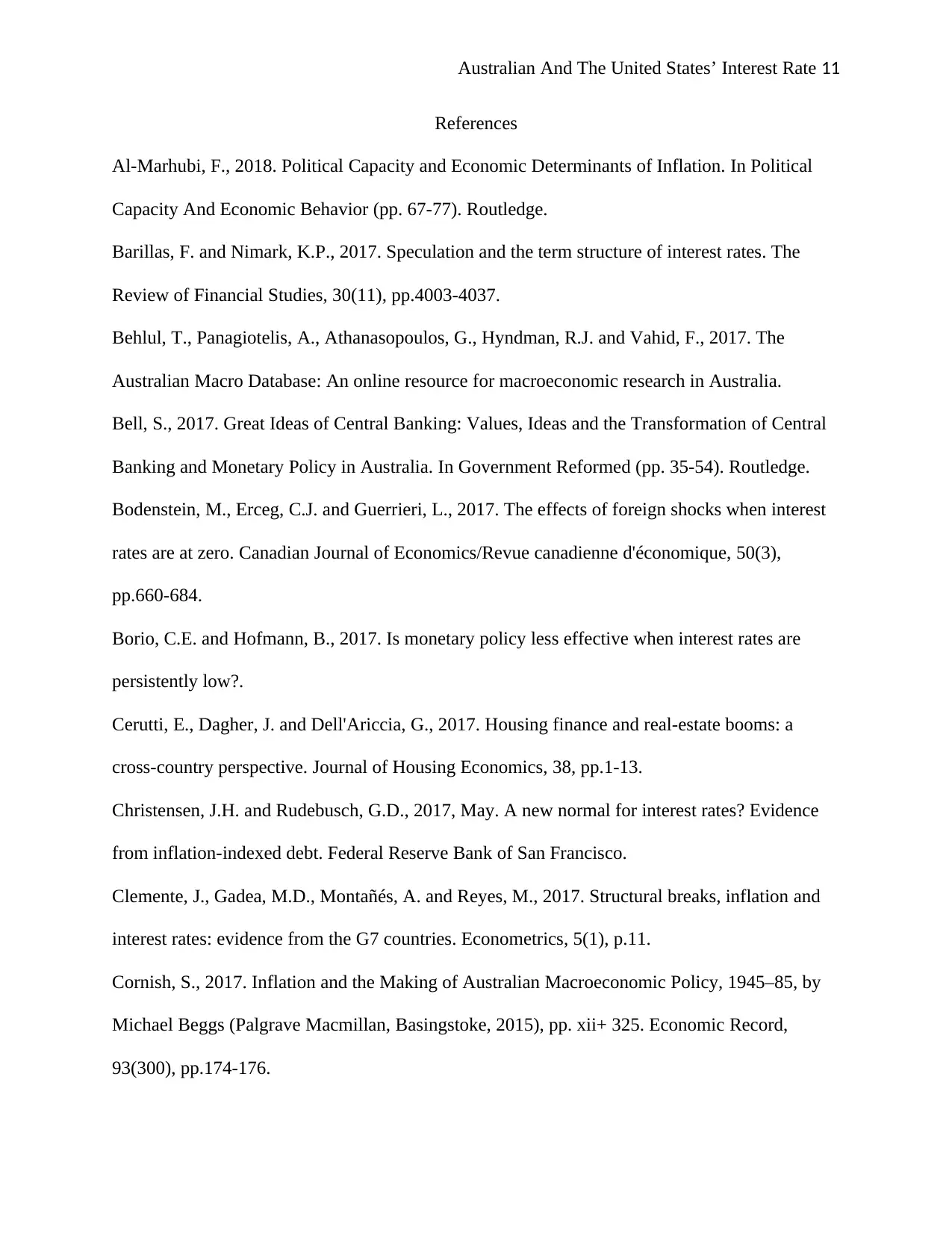
Australian And The United States’ Interest Rate 11
References
Al-Marhubi, F., 2018. Political Capacity and Economic Determinants of Inflation. In Political
Capacity And Economic Behavior (pp. 67-77). Routledge.
Barillas, F. and Nimark, K.P., 2017. Speculation and the term structure of interest rates. The
Review of Financial Studies, 30(11), pp.4003-4037.
Behlul, T., Panagiotelis, A., Athanasopoulos, G., Hyndman, R.J. and Vahid, F., 2017. The
Australian Macro Database: An online resource for macroeconomic research in Australia.
Bell, S., 2017. Great Ideas of Central Banking: Values, Ideas and the Transformation of Central
Banking and Monetary Policy in Australia. In Government Reformed (pp. 35-54). Routledge.
Bodenstein, M., Erceg, C.J. and Guerrieri, L., 2017. The effects of foreign shocks when interest
rates are at zero. Canadian Journal of Economics/Revue canadienne d'économique, 50(3),
pp.660-684.
Borio, C.E. and Hofmann, B., 2017. Is monetary policy less effective when interest rates are
persistently low?.
Cerutti, E., Dagher, J. and Dell'Ariccia, G., 2017. Housing finance and real-estate booms: a
cross-country perspective. Journal of Housing Economics, 38, pp.1-13.
Christensen, J.H. and Rudebusch, G.D., 2017, May. A new normal for interest rates? Evidence
from inflation-indexed debt. Federal Reserve Bank of San Francisco.
Clemente, J., Gadea, M.D., Montañés, A. and Reyes, M., 2017. Structural breaks, inflation and
interest rates: evidence from the G7 countries. Econometrics, 5(1), p.11.
Cornish, S., 2017. Inflation and the Making of Australian Macroeconomic Policy, 1945–85, by
Michael Beggs (Palgrave Macmillan, Basingstoke, 2015), pp. xii+ 325. Economic Record,
93(300), pp.174-176.
References
Al-Marhubi, F., 2018. Political Capacity and Economic Determinants of Inflation. In Political
Capacity And Economic Behavior (pp. 67-77). Routledge.
Barillas, F. and Nimark, K.P., 2017. Speculation and the term structure of interest rates. The
Review of Financial Studies, 30(11), pp.4003-4037.
Behlul, T., Panagiotelis, A., Athanasopoulos, G., Hyndman, R.J. and Vahid, F., 2017. The
Australian Macro Database: An online resource for macroeconomic research in Australia.
Bell, S., 2017. Great Ideas of Central Banking: Values, Ideas and the Transformation of Central
Banking and Monetary Policy in Australia. In Government Reformed (pp. 35-54). Routledge.
Bodenstein, M., Erceg, C.J. and Guerrieri, L., 2017. The effects of foreign shocks when interest
rates are at zero. Canadian Journal of Economics/Revue canadienne d'économique, 50(3),
pp.660-684.
Borio, C.E. and Hofmann, B., 2017. Is monetary policy less effective when interest rates are
persistently low?.
Cerutti, E., Dagher, J. and Dell'Ariccia, G., 2017. Housing finance and real-estate booms: a
cross-country perspective. Journal of Housing Economics, 38, pp.1-13.
Christensen, J.H. and Rudebusch, G.D., 2017, May. A new normal for interest rates? Evidence
from inflation-indexed debt. Federal Reserve Bank of San Francisco.
Clemente, J., Gadea, M.D., Montañés, A. and Reyes, M., 2017. Structural breaks, inflation and
interest rates: evidence from the G7 countries. Econometrics, 5(1), p.11.
Cornish, S., 2017. Inflation and the Making of Australian Macroeconomic Policy, 1945–85, by
Michael Beggs (Palgrave Macmillan, Basingstoke, 2015), pp. xii+ 325. Economic Record,
93(300), pp.174-176.
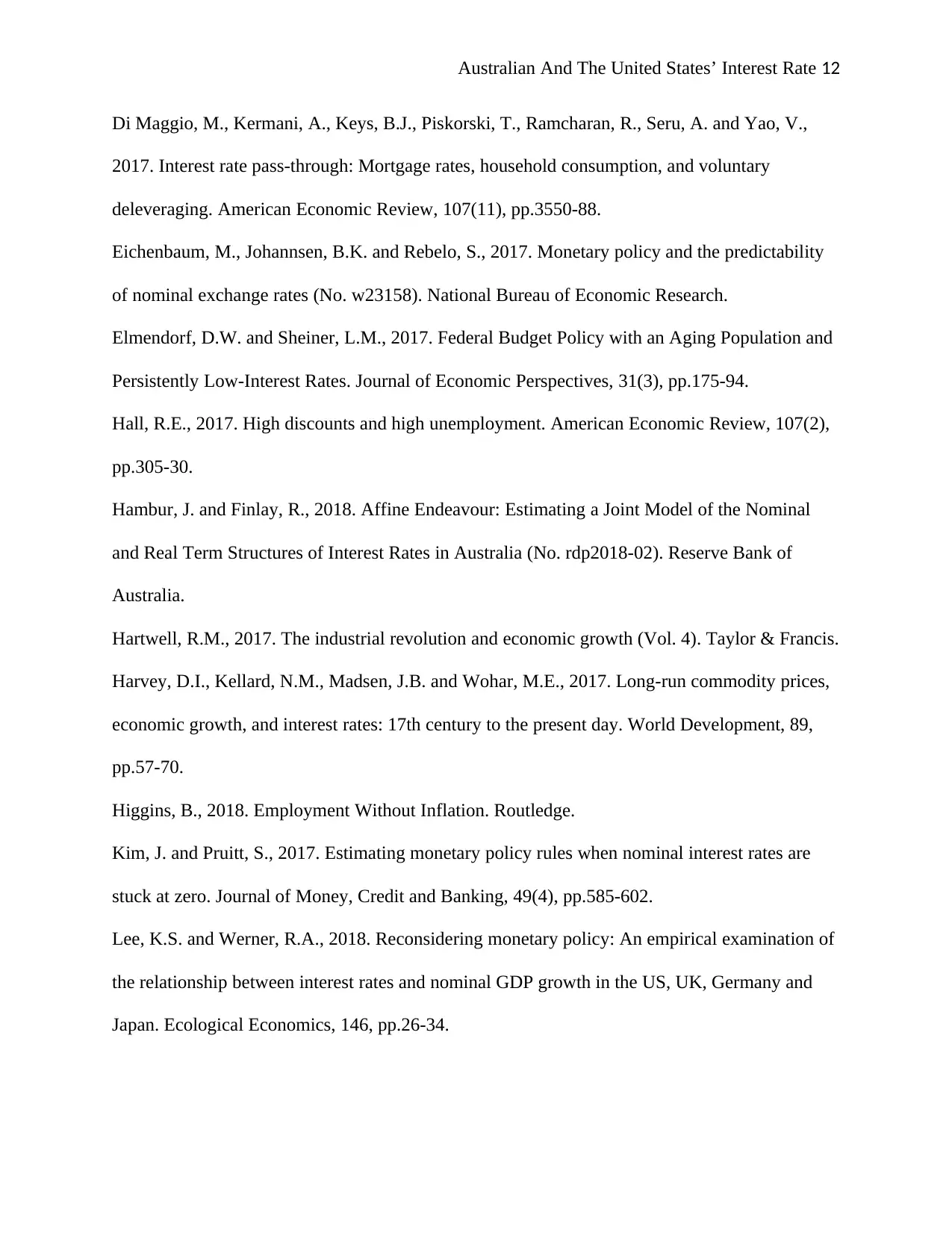
Australian And The United States’ Interest Rate 12
Di Maggio, M., Kermani, A., Keys, B.J., Piskorski, T., Ramcharan, R., Seru, A. and Yao, V.,
2017. Interest rate pass-through: Mortgage rates, household consumption, and voluntary
deleveraging. American Economic Review, 107(11), pp.3550-88.
Eichenbaum, M., Johannsen, B.K. and Rebelo, S., 2017. Monetary policy and the predictability
of nominal exchange rates (No. w23158). National Bureau of Economic Research.
Elmendorf, D.W. and Sheiner, L.M., 2017. Federal Budget Policy with an Aging Population and
Persistently Low-Interest Rates. Journal of Economic Perspectives, 31(3), pp.175-94.
Hall, R.E., 2017. High discounts and high unemployment. American Economic Review, 107(2),
pp.305-30.
Hambur, J. and Finlay, R., 2018. Affine Endeavour: Estimating a Joint Model of the Nominal
and Real Term Structures of Interest Rates in Australia (No. rdp2018-02). Reserve Bank of
Australia.
Hartwell, R.M., 2017. The industrial revolution and economic growth (Vol. 4). Taylor & Francis.
Harvey, D.I., Kellard, N.M., Madsen, J.B. and Wohar, M.E., 2017. Long-run commodity prices,
economic growth, and interest rates: 17th century to the present day. World Development, 89,
pp.57-70.
Higgins, B., 2018. Employment Without Inflation. Routledge.
Kim, J. and Pruitt, S., 2017. Estimating monetary policy rules when nominal interest rates are
stuck at zero. Journal of Money, Credit and Banking, 49(4), pp.585-602.
Lee, K.S. and Werner, R.A., 2018. Reconsidering monetary policy: An empirical examination of
the relationship between interest rates and nominal GDP growth in the US, UK, Germany and
Japan. Ecological Economics, 146, pp.26-34.
Di Maggio, M., Kermani, A., Keys, B.J., Piskorski, T., Ramcharan, R., Seru, A. and Yao, V.,
2017. Interest rate pass-through: Mortgage rates, household consumption, and voluntary
deleveraging. American Economic Review, 107(11), pp.3550-88.
Eichenbaum, M., Johannsen, B.K. and Rebelo, S., 2017. Monetary policy and the predictability
of nominal exchange rates (No. w23158). National Bureau of Economic Research.
Elmendorf, D.W. and Sheiner, L.M., 2017. Federal Budget Policy with an Aging Population and
Persistently Low-Interest Rates. Journal of Economic Perspectives, 31(3), pp.175-94.
Hall, R.E., 2017. High discounts and high unemployment. American Economic Review, 107(2),
pp.305-30.
Hambur, J. and Finlay, R., 2018. Affine Endeavour: Estimating a Joint Model of the Nominal
and Real Term Structures of Interest Rates in Australia (No. rdp2018-02). Reserve Bank of
Australia.
Hartwell, R.M., 2017. The industrial revolution and economic growth (Vol. 4). Taylor & Francis.
Harvey, D.I., Kellard, N.M., Madsen, J.B. and Wohar, M.E., 2017. Long-run commodity prices,
economic growth, and interest rates: 17th century to the present day. World Development, 89,
pp.57-70.
Higgins, B., 2018. Employment Without Inflation. Routledge.
Kim, J. and Pruitt, S., 2017. Estimating monetary policy rules when nominal interest rates are
stuck at zero. Journal of Money, Credit and Banking, 49(4), pp.585-602.
Lee, K.S. and Werner, R.A., 2018. Reconsidering monetary policy: An empirical examination of
the relationship between interest rates and nominal GDP growth in the US, UK, Germany and
Japan. Ecological Economics, 146, pp.26-34.
⊘ This is a preview!⊘
Do you want full access?
Subscribe today to unlock all pages.

Trusted by 1+ million students worldwide
1 out of 14
Related Documents
Your All-in-One AI-Powered Toolkit for Academic Success.
+13062052269
info@desklib.com
Available 24*7 on WhatsApp / Email
![[object Object]](/_next/static/media/star-bottom.7253800d.svg)
Unlock your academic potential
Copyright © 2020–2025 A2Z Services. All Rights Reserved. Developed and managed by ZUCOL.





